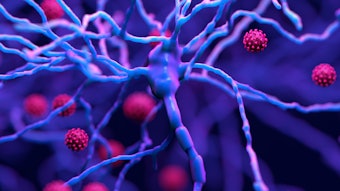Session explores controversies tied to managing intracerebral hemorrhage and ischemic stroke
Current recommendations for managing hypertension in acute stroke and controversies tied to study findings for intracerebral hemorrhage and ischemic stroke.

Patients with acute intracerebral hemorrhage experience a high rate of morbidity and mortality with deficits in outcomes much worse than in ischemic stroke overall.
“We still don’t know the best and safest target blood pressure for many patients in the acute period,” said Wendy Dusenbury, DNP, APRN, AGACNP-BC, AVNP-BC, University of Tennessee Health Science Center in Wednesday’s session: “Clinical Considerations in Acute Hypertension Management.”
To promote continued research and improve outcomes for this vulnerable population, the session explores research supporting current recommendations for managing hypertension in acute stroke and controversies tied to specific study findings for intracerebral hemorrhage and ischemic stroke.
In Dusenbury’s presentation, “Are Blood Pressure Targets Appropriate for All Patients with Acute Intracerebral Hemorrhage?” Dusenbury compares the outcomes of two landmark clinical trials, INTERACT 2 and ATACH 2, which examined the effect of intensive reduction of systolic blood pressure to standard reduction in the acute period in patients who had a spontaneous intracerebral hemorrhage.
The Intensive Blood Pressure Reduction in Acute Cerebral Hemorrhage Trial 2 (INTERACT 2) randomized 2,839 patients with spontaneous intracerebral hemorrhage within the previous six hours who had elevated systolic blood pressure to receive either intensive treatment with lowering of blood pressure to a target systolic level of <140 mm Hg or guideline-recommended treatment lowering to systolic <180 mm Hg; physicians could use whatever drug agent they wanted in this study. Of the enrolled patients, 53% had a systolic blood pressure <180 mm Hg at baseline before blood pressure lowering commenced.
“That’s concerning because many patients with intracerebral hemorrhage are admitted with significantly higher blood pressures with systolic well above 200 mm Hg, so this challenges generalizability of these findings to these severely hypertensive patients,” Dusenbury said. Median hematoma volume in the study was 11 cm3, further challenging generalizability to patients with larger hematomas.
The Antihypertensive Treatment of Acute Cerebral Hemorrhage II (ATACH 2) randomized 1,000 patients with intracerebral hemorrhage volumes <60 cm3 and a Glasgow Coma Scale score of 5 or more to either a systolic blood-pressure target of 110 to 139 mm Hg (intensive treatment) or a target of 140 to 179 mm Hg (standard treatment).
In ATACH 2, all subjects had baseline pre-treatment systolic blood pressures >180 mm Hg. Median hematoma volume was similar between groups at 10.3 cm3 in the intensive lowering group and 10.4 cm3 in the standard group; 9.1% of patients the intensive group and 10.4% of patients in the standard group had hematoma volumes greater than 30 cm3.
In both trials, there was no difference in mortality or hematoma expansion between the intensive blood pressure lowering and standard groups. However, patients in INTERACT2 showed a trend (p=0.06) toward improved mRS at 3 months.
“It remains unclear why intensive blood pressure lowering patients in INTERACT2 showed this trend because it cannot be explained by differences in hematoma volume, and a subsequent publication reported intervention fidelity concerns showing that 66% of INTERACT2 patients in the intensive blood pressure lowering group never achieved the blood pressure targets,” Dusenbury said.
In ATACH2, the rate of 7-day renal adverse events was significantly higher in the trial’s intensive blood pressure lowering group, as were the number of intensive treatment patients with serious adverse events occurring in the three months after randomization. Also, an estimated 41% of patients in INTERACT2 were randomized later than 4 hours after onset, whereas 100% of ATACH2 patients were randomized and treated within 4.5 hours from symptom onset.
“We don’t yet know whether ultra-early blood pressure lowering within 1 to 2 hours of symptom onset would be beneficial, nor do we know what blood pressure targets would be safest for patients with severe hypertension and/or large hematoma volumes,” Dusenbury said.
The session also explored controversies surrounding transition from intravenous to oral antihypertensive agents and evidence supporting use of noninvasive oscillometric blood pressure monitoring. Overall, Dusenbury advocated for more research to support a personalized medicine approach to care to address clinical questions regarding the best blood pressure target for intracerebral hemorrhage patients having baseline systolic blood pressures > 220 mm Hg.








